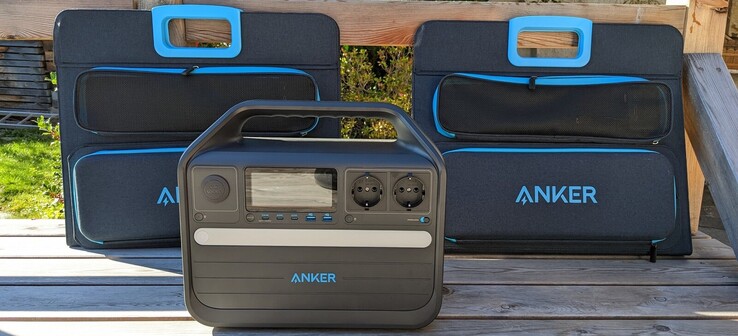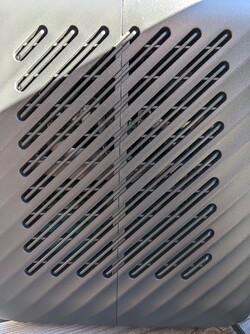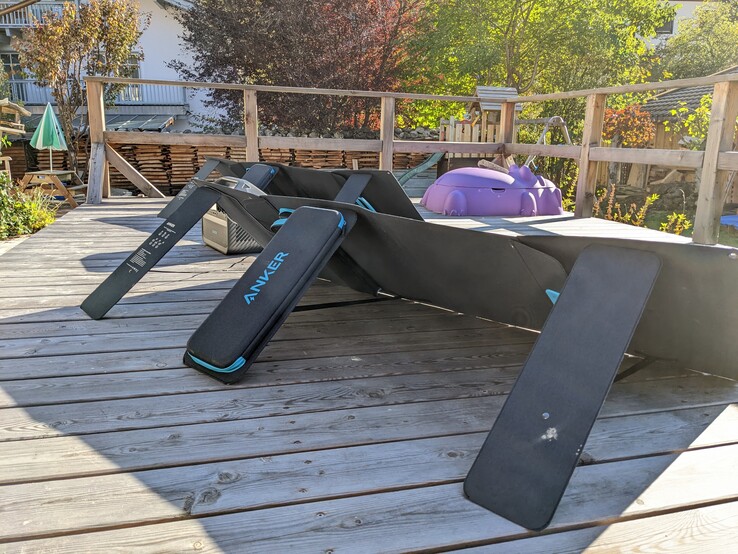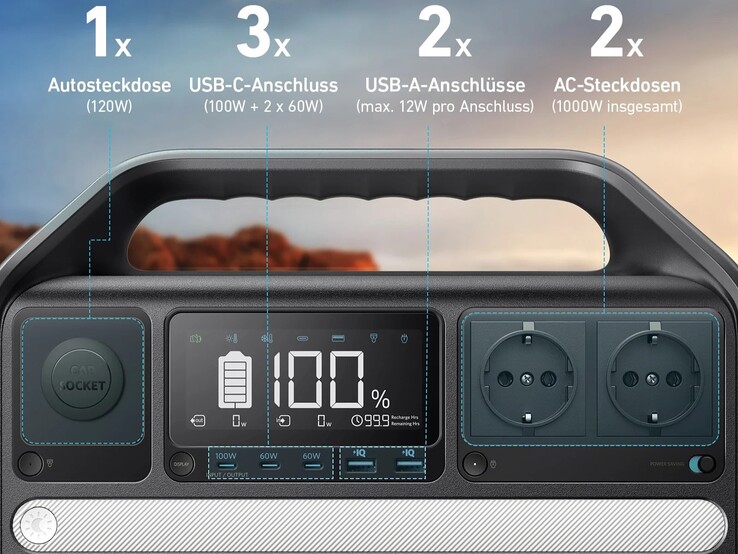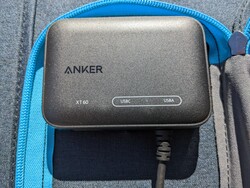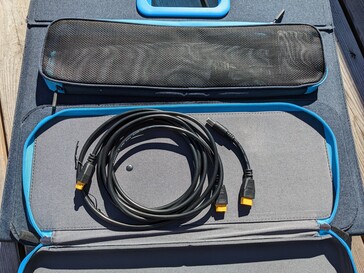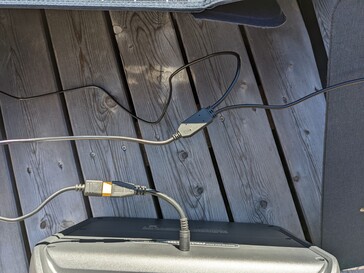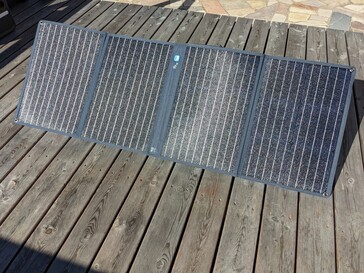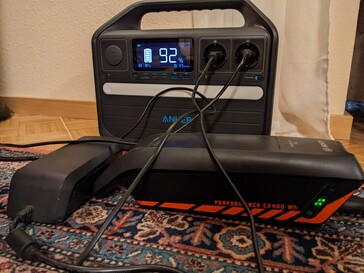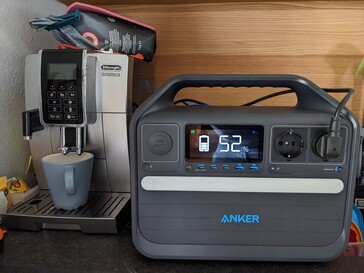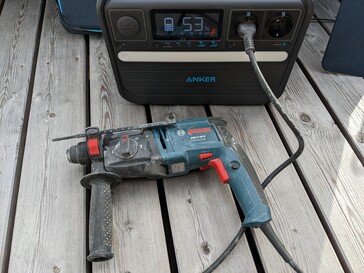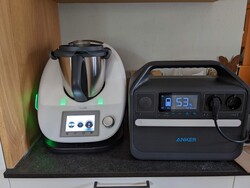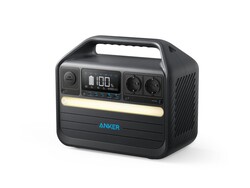Anker Powerhouse 555 with solar modules hands-on review: Emergency power station?
Anker not only supplies handy power banks, but also energy storage devices that are significantly larger - mobile charging stations. The manufacturer calls its own devices Powerhouse. The devices are available in different power levels between 256 and soon 2048 Wh capacity.
The test device is called Powerhouse 555 and offers a capacity of 1024 Wh. It can deliver a maximum of 1000 Watts and can be charged via solar panels. Two Anker 625 solar panels are used in the test, which can deliver up to 100 watts each.
Power & Function - Anker Powerhouse 555 with 1000 Watts
Anker installs iron phosphate batteries (LiFePO4) in Powerhouse 555. These are supposed to be more robust against external influences on the one hand and more durable than lithium-ion batteries on the other. Anker promises that the cells are designed for 3000 charging cycles.
The Powerstation has a capacity of 1024 Wh and can deliver a maximum of 1000 watts. It weighs 13.37 kilos and is thus just about transportable without back pain in combination with the large bracket.
Areas of application - The Anker power station is versatile
There are many possible use cases for a power station. On the one hand, the device can serve as an emergency power supply in the event of a power failure. Household appliances such as a refrigerator, a kettle, or a stovetop can be operated with it. Technical devices such as smartphones or laptops can of course also be charged.
In addition, the powerhouse is also suitable for camping trips due to its form factor and weight. In this context, the car socket is also useful, because some camping devices are designed for power supply via the cigarette lighter in the car. The charging option via this connection in the car is also useful for this field. The integrated lamp of the Powerhouse 555 is also convincing for this use.
The third scenario is power in places where an outlet is missing, such as in the garden. The energy storage unit can be used to operate tools that rely on electricity. Cable drums and multiple extensions can stay in the basement with the Anker Powerhouse 555.
Lastly, the Powerstation in conjunction with the solar panels offers a way to save electricity, similar to a balcony power station. Although the generated energy cannot be fed into the house grid, devices can be operated via the battery, which is charged at the same time or next opportunity.
Connections - Wide variety at the powerhouse
The Anker Powerhouse 555 offers a total of eight ports on the front that can be used to power devices. The five USB ports are always active. The two AC outlets and the car outlet can each be activated or deactivated via a button to save power. When the power-saving mode is enabled, the Powerhouse automatically removes power from ports when they are not in use.
The maximum power of 1000 watts can only be delivered via the AC outlets. The two USB-A ports deliver a maximum of 12 watts each. The three USB-C ports differ in power. Two of them output a maximum of 60 watts. The third supplies a maximum of 100 watts, and the power station can also be charged via it. A maximum of 120 watts can be delivered via the 12-volt car socket.
The display provides information about the power available at the respective ports. The current charge level of the power station is indicated there, but also how many watts are present at which type of plug. The device indicates how many watts it is currently being charged. If a device is connected, the display also informs how long the battery will last at the current power or how long it will charge until it is full.
Outputs & Usage
In total, the Powerhouse 555 can deliver 1000 watts via its eight ports. There is no prioritization between the ports.
Not only the power station has outputs, but also solar panels. Each panel has both an XT-60 output, but also a USB-A and a USB-C port. This means that end devices can be charged directly without the need for an intermediate route via the powerhouse. A maximum of 15 watts of power is possible directly at the panel.
Inputs & Charging
The Powerhouse 555 is charged via either a DC7909 port on the back or a USB-C port on the front. There are three options for charging: a household outlet, a 12-volt connection in the car, or solar panels.
The included power adapter is large and weighs 826 grams, with a maximum output of 200 watts. Anker states that an 80 percent charge is reached after 4.1 hours. The battery can be charged with a maximum of 100 watts via the USB-C port on the front.
If the sun is shining, the Powerhouse 555 can also be charged with solar panels. Anker states that the Powerhouse can be operated with any solar charger that works with a voltage between 11 and 28 volts and has a DC 7909 plug. Two Anker 625 panels, each with 100 watts, were used in the test. The panels each come with an XT-60 to DC 7909 adapter cable. To be able to use two panels at the same time, a Y-spilt is included in the scope of delivery of the power station.
A panel consists of four equally sized areas of 36 by 53 centimeters. An unfolded panel is 145 by 53 centimeters, which is an area of about 0.77 square meters. However, due to the fabric connections between the panels, the area that generates electricity is smaller.
Practical experience - Many things are possible with the Powerhouse, but not everything
While watching TV, the fan of the Powerhouse 555 is particularly noticeable. After about 15 minutes with a plugged-in running TV, Chromecast Ultra and a floor lamp, the fan of the powerhouse starts to run audibly. The noise is not intrusive, and the sound of the movie does not need to be turned up, but the fan noise is present, even in scenes with background noise. The fan's speed fluctuates during operation, even when the energy consumption remains constant.
We reached the maximum power with a hot plate that consumes 1000 watts. The plate warms up quickly and does not drop out. According to the display, the operation is possible for one hour.
We also tried other household appliances and tools. A Thermomix TM5 runs without problems when connected to the Powerhouse 555. Both mixing and heating are no problem for the Powerhouse, and the Thermomix draws a maximum of 957 watts.
However, the Delonghi Dynamica fully automatic coffee machine pushed the power station to its limits. The machine turned on, the Powerhouse display showed 1355 watts for a few seconds, then the coffee machine turned off again.
The picture is also divided when it comes to tools. While a Bosch Professional GBH 2-20 hammer drill works without problems, a large angle grinder starts up, revs up a bit twice, but then dies. However, the said Flex also needs 2000 watts for full power.
We like the fact that the Powerhouse can be charged via solar panels while simultaneously powering other devices. If the output power is higher than the input power, the battery capacity is simply used. Thus, we charged e-bike batteries with the Powerhouse in the test while the station itself was connected to solar panels. The display provides a good overview of the respective power in real-time.
The Anker 625 solar panels impress with their form factor. When folded, they are easy to carry thanks to the integrated handle, even though they are not particularly light at 5.3 kilograms each. We like the small control panel that can be used to align the panels. The goal is for the shadow of a point to fall in the center of a circle, then the sunlight incidence is optimal, according to Anker
Three supports are built into each panel to help with set-up. On a smooth or slippery surface - such as a terrace with wooden floorboards - adjustment is difficult, however, because the feet easily slide back into the maximum position.
It's also noticeable that the panels have to be moved frequently to follow the sun's position if you want to reach maximum power. We never reached the arithmetically possible 200 watts in the test; in the October sun, the Powerhouse was charged with a maximum of 194 watts. The influence of the orientation is nicely visualized thanks to the corresponding watt display in the display. On a predominantly sunny day, the Powerhouse 555 can only be fully recharged with solar panels.
Verdict - Convincing all-round helper from Anker
The Powerhouse 555 from Anker can be many things. Rescuer in a power outage, helper in the garden, or comfort plus when camping. The power storage unit is particularly appealing in combination with solar panels. With its size and weight, it is still manageable and yet offers enough power for many devices.
If a fixed usage scenario is planned, it should in any case be checked beforehand how much energy the respective devices consume to function properly. Many electrical appliances require a high starting power, which the power station partly cannot provide. The Powerhouse 555 is also too small for a double hotplate. Therefore, it is important to consider the intended use when selecting the device. In contrast to the Powerstation 757, the 555 also lacks a fast charging function.
If a lot of power is needed, for example for tools, the Powerhouse 555 reaches its limits. Everyday tasks like charging smartphones, laptops, or e-bike batteries, on the other hand, are no problem.
The option to charge the power station simultaneously while using it is convincing. The display is also well-designed. It is easy to read and provides real-time information about performance values and forecasts for charging or runtimes.
The Powerhouse 555 is a successful all-rounder for most tasks. If more power is needed, Anker also supplies larger alternatives like the Powerhouse 757 or the 767, which deliver up to 2400 watts but are also much bulkier. Also delivering more power is the Bluetti AC200Max but it also plays in a different weight class.
Price and availability
Anker charges 1,300 Euros for the Powerhouse 555 - without solar panels. Each 625 panel costs 370 euros extra, and a maximum of two can be connected. Anker offers a set consisting of the Powerstation and two solar panels, for which the manufacturer charges in its own store 1.900 euros. The power station is not only available from the manufacturer, but also from other retailers, such as Amazon.
Anker grants a 5-year warranty on the Powerhouse. The solar modules have an 18-month warranty.


 Deutsch
Deutsch English
English Español
Español Français
Français Italiano
Italiano Nederlands
Nederlands Polski
Polski Português
Português Русский
Русский Türkçe
Türkçe Svenska
Svenska Chinese
Chinese Magyar
Magyar